Source: http://www.glassinesurfer.com/stamp_collecting/gssweatbox.shtml
Sometimes soaking isn’t the solution. Sometimes it’s best to let humidity work on the glue before you try to remove a hinge remnant or separate a mint stamp stuck to another stamp or an album page. The same trick works for getting stamps off envelopes whose inks you know will discolor the stamp when placed in water.
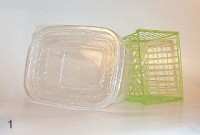
If you live in a hot, humid area you could experiment with exposing your stamps to the elements, but for most of us the answer is a sweat box. It’s simply an airtight container with a couple of sponges and a cradle to keep the stamps from coming into direct contact with the sponges.
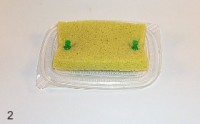
The basic idea is to raise the humidity in the sweat box so that it dampens the stamp’s gum just enough to loosen the stamp from whatever it’s stuck on without saturating the stamp or the paper, or diluting the gum.
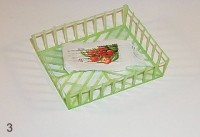
The basic parts of the sweat box are
1. A small air tight container. (picture #1) A small, clear plastic disposable air-tight food container works well. The smaller the container, the quicker the humidy rises. If it’s clear you can check on the stamp’s progress without opening the container, which would then also drop the humidity.
2. A clean, never-used sponge or two to hold the water moisture. (picture #5) Two clean kitchen sponges are fine. You can try this out with what you have in the kitchen, but if you want to keep your sweat box working, you’ll want to replace them with never-used sponges.
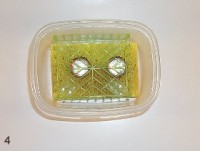
3. A screen on which the stamp on piece rests. I used a plastic basket that stores sell strawberries in. (picture #1) I then trimmed the sides down low enough to fit between the two sponges.
4. Spacers (picture #4) These raise the screen above the bottom sponge and must be non-porous, plastic, metal or cork. I used two bottle caps, but now use two pieces from a backgammon set.
To put together a your own homemade sweat box read the following and refer to the pictures.
1. Soak the bottom sponge in water. Wring it out so that it is still heavy and wet with water but not dripping and place it on the bottom of your box.
2. Affix the top sponge to the center of your box’s top lid with two push pins as shown in picture #2.
3. Soak the top sponge in water and wring it out so that it is still heavy and wet with water but not dripping.
4. Now trim your screen so that it will fit between the upper and lower sponge. See picture #3.
5. Place your two spacers on top of the bottom sponge and rest your screen on top of it. See picture #4
6. When finished and set up, it looks something like this. See picture #5. In a while, depending on the sponge water, the size of the box, ambient temperature, humidity and sunlight on the box, water droplets will form on the sides of the box.
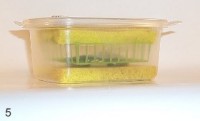
7. I cut a wine cork into ½” thicknesses and used them to cover the sharp ends of the push pins holding the top sponge in place on the cover.
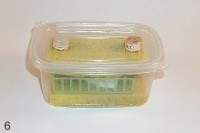
The object of the sweat box is to have the humidity in the box seep through the paper and loosen the stamp’s gum, but remember paper and gum interact in different ways depending on the age of the paper, the age and condition of the gum and the humidity.
Self-adhesive stamps can be sweated off, but what happens with a SA stamp is that the binder layer dissolves separating the top paper layer from the bottom adhesive layer so that you can’t save the stamp with its adhesive.
And if you think stronger measures are necessary, just give the sweat box more time to work. Remember “STEAM is EXTREME.”
With a little experience and patience most glues finally break down under the humidity. Expect a gummed stamp to take 30 minutes to loosen from paper, and gummed mint stamps a bit longer to release from each other.